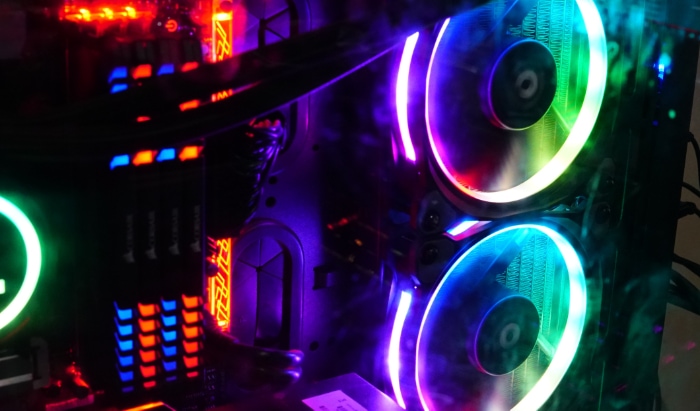RGB vs. ARGB: Understanding the Differences

Lighting has become an essential aspect of modern computer hardware and gaming setups, adding a touch of personalization and enhancing the overall aesthetics. With the rise of RGB (Red, Green, Blue) and ARGB (Addressable Red, Green, Blue) lighting solutions, users now have the ability to create visually stunning and immersive environments that cater to their preferences and styles.
This blog post aims to provide a comprehensive understanding of both RGB and ARGB lighting solutions, highlighting their differences and helping you make an informed decision when choosing the right lighting solution for your needs.
We will delve into the components of each system, explore popular uses, and evaluate the pros and cons to ensure you are well-equipped to create the perfect lighting setup that complements your gaming or computer hardware experience.
Understanding RGB Lighting
RGB lighting refers to a technology that utilizes the combination of red, green, and blue light-emitting diodes (LEDs) to create a wide range of colors.
By varying the intensity of each color channel, RGB lighting systems can produce millions of different colors, allowing users to customize their hardware and gaming setups with unique and vibrant color schemes.
Components of RGB Lighting Systems
LED Strips
These are flexible strips containing multiple RGB LEDs that can be attached to various surfaces, such as the inside of a computer case or behind a monitor. LED strips are available in different lengths and can be cut to size or connected together for larger installations.
Controllers
RGB lighting controllers are devices used to manage the color and brightness of the connected LED strips. These controllers often come with built-in presets and modes, such as static colors, breathing effects, or color cycling.
Some controllers can be connected to the motherboard, allowing users to synchronize the lighting with other RGB components in their systems.
Software
Many RGB lighting systems include software that allows users to control and customize the color schemes and effects through a graphical user interface. This software may be specific to the manufacturer or compatible with multiple hardware brands.
The RGB Color Model in Computer Hardware
The RGB color model is based on the principle of additive color mixing, where the primary colors of red, green, and blue light can be combined in various proportions to produce a wide range of colors.
In computer hardware, the RGB color model is used to represent colors on screens and digital images, as well as in lighting solutions like RGB LED systems.
Popular Uses of RGB Lighting
Gaming Setups
RGB lighting is a popular choice for gamers looking to enhance the ambiance of their gaming spaces, creating a more immersive and personalized environment.
PC Cases
Many computer cases now feature integrated RGB lighting or have provisions for adding LED strips, allowing users to showcase their systems with vibrant and dynamic color schemes.
Keyboards and Mice
RGB lighting has also found its way into peripherals like keyboards and mice, enabling users to match their accessories with the rest of their setups.
Monitors
Some gaming monitors come with built-in RGB lighting, which can be synchronized with other components to create a cohesive lighting theme throughout the entire setup.
Understanding ARGB Lighting
ARGB, or Addressable RGB lighting, is an advanced version of the traditional RGB lighting system. It allows for individual control of each LED on a strip, enabling a higher level of customization and more complex lighting effects.
By independently adjusting the color and intensity of each LED, users can create intricate patterns, gradients, and animations that are not possible with standard RGB lighting.
Key Differences Between ARGB and RGB Lighting
Independent LED Control
While RGB lighting requires all LEDs on a strip to display the same color, ARGB lighting allows each LED to be controlled separately. This independent control provides users with greater creative freedom to design unique and intricate lighting effects.
Greater Color Depth and Customization
ARGB lighting systems typically have a higher color depth than RGB systems, meaning they can produce a broader range of colors with more accurate color representation. This increased color depth, combined with individual LED control, provides users with almost limitless customization options.
Components of ARGB Lighting Systems
LED Strips
ARGB LED strips are similar to RGB LED strips but feature individually addressable LEDs. These strips can be installed in various locations, such as inside computer cases or behind monitors, and can be customized to create complex lighting patterns and effects.
Controllers
ARGB controllers manage the color, brightness, and effects of the connected ARGB LED strips. These controllers often support more advanced lighting modes and can synchronize with other ARGB components in a system. Some ARGB controllers can be connected to a motherboard, allowing for seamless integration with existing hardware.
Software
Like RGB lighting systems, ARGB lighting solutions often include software for controlling and customizing the lighting effects. This software usually offers a more extensive range of options and settings due to the increased capabilities of ARGB systems.
Users can create custom color profiles, sync lighting with other components, and even program intricate animations.
Popular Uses of ARGB Lighting

Gaming Setups
ARGB lighting is an excellent option for gamers who want to take their setups to the next level, offering a more immersive and visually engaging experience with complex lighting effects.
PC Cases
Computer cases with integrated ARGB lighting or provisions for adding ARGB LED strips allow users to create dynamic and eye-catching displays that showcase their systems.
Keyboards and Mice
ARGB lighting is becoming increasingly popular in peripherals like keyboards and mice, providing users with a higher level of customization and visual appeal.
Monitors
Some gaming monitors now feature built-in ARGB lighting, which can be synchronized with other components to create a fully integrated and cohesive lighting theme throughout the entire setup.
Comparing RGB and ARGB Lighting: Pros and Cons
In this section, we will compare and contrast RGB and ARGB lighting systems, discussing the pros and cons of each.
RGB Lighting Pros
- Cost-Effective: RGB lighting systems are generally more affordable than their ARGB counterparts, making them a budget-friendly option for those looking to add a touch of customization to their setups without breaking the bank.
- Simplicity and Ease of Use: RGB lighting systems are often simpler to install and configure than ARGB systems, making them more accessible for users who may not be as technologically savvy or prefer a more straightforward setup process.
- Compatibility with Older Hardware: RGB lighting solutions tend to be more compatible with a wider range of hardware, including older components, allowing users to upgrade their existing setups without needing to replace multiple parts.
RGB Lighting Cons
- Limited Customization Options: Due to the nature of RGB lighting, customization options are more limited compared to ARGB systems, as all LEDs on a strip must display the same color.
- Entire Strip Displays the Same Color: RGB lighting systems lack the individual LED control found in ARGB solutions, which means that users are unable to create more intricate lighting patterns or effects.
- Lower Color Depth: RGB lighting typically has a lower color depth than ARGB lighting, resulting in a narrower range of colors and less accurate color representation.
ARGB Lighting Pros
- Higher Level of Customization: ARGB lighting systems offer a higher level of customization thanks to their independent LED control, allowing users to create unique and intricate lighting effects that are not possible with standard RGB systems.
- Independent LED Control: With the ability to control each LED individually, ARGB lighting solutions provide users with more creative freedom when designing their lighting setups.
- Greater Color Depth: ARGB lighting systems generally have a higher color depth than RGB systems, resulting in a broader range of colors and more accurate color representation.
ARGB Lighting Cons
- Higher Cost: ARGB lighting solutions tend to be more expensive than RGB systems, which may be a consideration for users with budget constraints.
- Compatibility Issues with Older Hardware: Due to their more advanced technology, ARGB lighting systems may not be compatible with some older hardware, potentially requiring users to upgrade their components to fully utilize the benefits of ARGB lighting.
- Complexity in Setup and Configuration: The installation and configuration process for ARGB lighting systems can be more complex and time-consuming than that of RGB systems, potentially posing a challenge for users who are less technologically inclined or prefer a simpler setup process.
Choosing the Right Lighting Solution

In this section, we will provide guidance on how to choose the right lighting solution for your specific needs.
Factors to Consider When Choosing Between RGB and ARGB
Budget
Your budget plays a significant role in determining whether to opt for RGB or ARGB lighting. RGB lighting is generally more affordable, while ARGB systems tend to be more expensive due to their advanced features and capabilities.
Compatibility
Consider the compatibility of the lighting solution with your existing hardware. RGB lighting is more likely to be compatible with a wider range of components, including older hardware. On the other hand, ARGB systems may require more recent components to fully take advantage of their features.
Customization Needs
Evaluate your customization preferences and requirements. If you desire intricate lighting patterns, animations, or a broader range of colors, an ARGB system may be more suitable. However, if you prefer simpler lighting effects and are satisfied with a more limited color palette, an RGB system may suffice.
Ease of Use and Setup
Consider the installation and configuration process when selecting a lighting solution. RGB systems are typically easier to install and configure, making them more accessible for those who may not be as technologically inclined. ARGB systems can be more complex and time-consuming to set up but offer greater customization options.
Tips for Selecting the Right Components
Research Compatibility Between Hardware and Lighting Systems
Before purchasing a lighting system, research the compatibility of the components with your existing hardware. Ensure that the system you choose will work seamlessly with your current setup to avoid potential issues and additional expenses.
Determine Your Personal Preferences and Priorities
Consider your personal preferences and priorities when selecting a lighting solution. Are you more concerned with cost or customization capabilities? Do you prefer ease of installation or a broader range of lighting effects? By evaluating your priorities, you can make a more informed decision when choosing between RGB and ARGB systems.
Read Reviews and Recommendations
Take the time to read reviews and recommendations from other users who have experience with the lighting systems you are considering. This can provide valuable insights into the performance, ease of use, and compatibility of various options, helping you make a more informed decision.
Conclusion
In conclusion, both RGB and ARGB lighting solutions offer unique advantages and drawbacks, catering to different user preferences and priorities. RGB systems provide a more cost-effective and straightforward option, making them suitable for users who prefer simplicity and ease of use.
On the other hand, ARGB lighting systems offer a higher level of customization, independent LED control, and greater color depth, appealing to those who seek advanced lighting effects and a more immersive experience.
When choosing the right lighting solution for your needs, it is essential to consider factors such as budget, compatibility, customization requirements, and ease of use.
By thoroughly evaluating these aspects and researching the available options, you can confidently select the ideal lighting system that will enhance your gaming or computer hardware setup and create a personalized environment that reflects your style and preferences.


